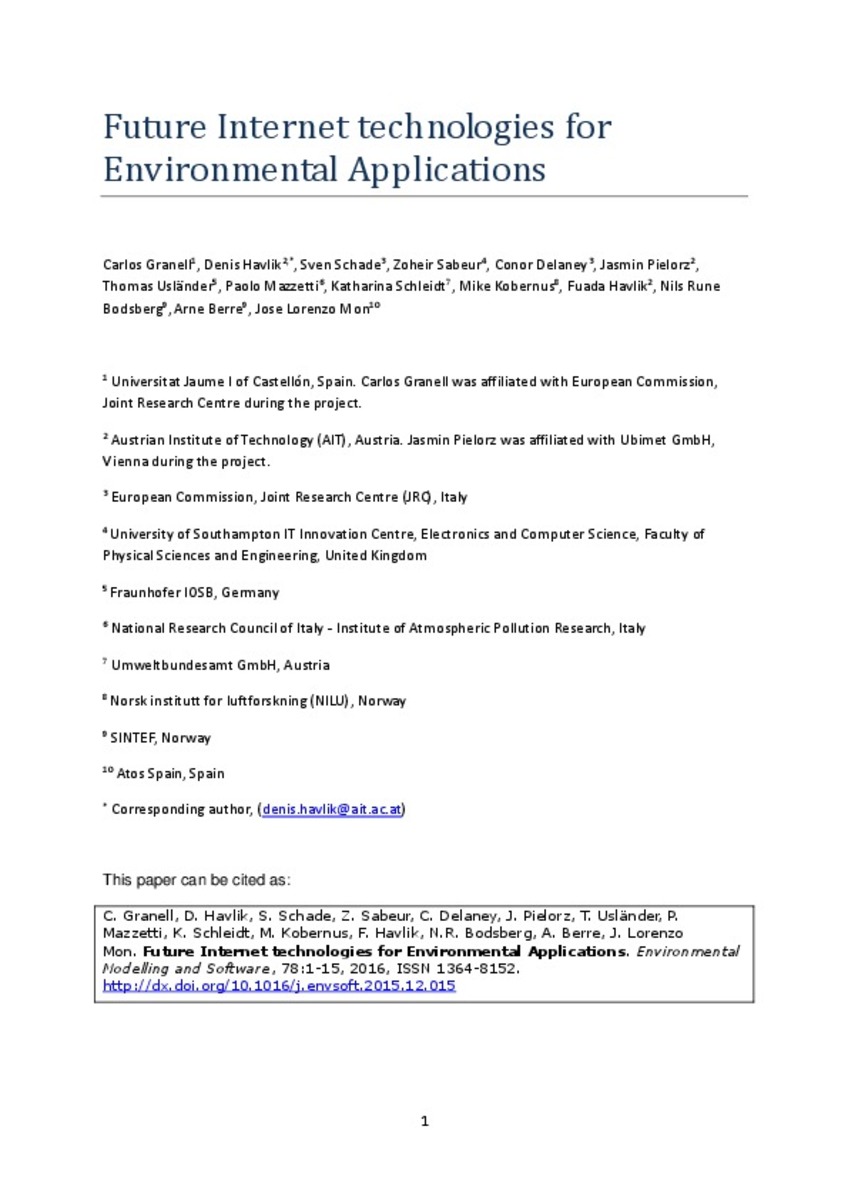Mostra el registre parcial de l'element
Future Internet technologies for Environmental Applications
| dc.contributor.author | Granell, Carlos | |
| dc.contributor.author | Havlik, Denis | |
| dc.contributor.author | Schade, Sven | |
| dc.contributor.author | Sabeur, Zoheir | |
| dc.contributor.author | Delaney, Conor | |
| dc.contributor.author | Pielorz, Jasmin | |
| dc.contributor.author | Usländer, Thomas | |
| dc.contributor.author | Mazzetti, Paolo | |
| dc.contributor.author | Schleidt, Katharina | |
| dc.contributor.author | Kobernus, Mike | |
| dc.contributor.author | Havlik, Fuada | |
| dc.contributor.author | Rune Bodsberg, Nils | |
| dc.contributor.author | Berre, Arne | |
| dc.contributor.author | Mon, Jose Lorenzo | |
| dc.date.accessioned | 2016-10-03T13:34:45Z | |
| dc.date.available | 2016-10-03T13:34:45Z | |
| dc.date.issued | 2016 | |
| dc.identifier.citation | GRANELL, Carlos, et al. Future Internet technologies for environmental applications. Environmental Modelling & Software, 2016, vol. 78, p. 1-15. | ca_CA |
| dc.identifier.issn | 1364-8152 | |
| dc.identifier.issn | 1873-6726 | |
| dc.identifier.uri | http://hdl.handle.net/10234/163376 | |
| dc.description.abstract | This paper investigates the usability of Future Internet technologies (aka “Generic Enablers of the Future Internet”) in the context of environmental applications. The paper incorporates the best aspects of the state-of-the-art in environmental informatics with geospatial solutions and scalable processing capabilities of Internet-based tools. It specifically targets the promotion of the “Environmental Observation Web” as an observation-centric paradigm for building the next generation of environmental applications. In the Environmental Observation Web, the great majority of data are considered as observations. These can be generated from sensors (hardware), numerical simulations (models), as well as by humans (human sensors). Independently from the observation provenance and application scope, data can be represented and processed in a standardised way in order to understand environmental processes and their interdependencies. The development of cross-domain applications is then leveraged by technologies such as Cloud Computing, Internet of Things, Big Data Processing and Analytics. For example, “the cloud” can satisfy the peak-performance needs of applications which may occasionally use large amounts of processing power at a fraction of the price of a dedicated server farm. The paper also addresses the need for Specific Enablers that connect mainstream Future Internet capabilities with sensor and geospatial technologies. Main categories of such Specific Enablers are described with an overall architectural approach for developing environmental applications and exemplar use cases. | ca_CA |
| dc.format.extent | 34 p. | ca_CA |
| dc.format.mimetype | application/pdf | ca_CA |
| dc.language.iso | eng | ca_CA |
| dc.publisher | Elsevier | ca_CA |
| dc.relation.isPartOf | Environmental Modelling & Software, 2016, vol. 78, p. 1-15. | ca_CA |
| dc.rights | Copyright © 2015 Elsevier Ltd. All rights reserved. | ca_CA |
| dc.rights | Atribución-NoComercial-SinDerivadas 4.0 España | * |
| dc.rights.uri | http://creativecommons.org/licenses/by-nc-nd/4.0/ | * |
| dc.subject | Environmental informatics | ca_CA |
| dc.subject | Environmental observation web | ca_CA |
| dc.subject | Future internet | ca_CA |
| dc.subject | Cloud computing | ca_CA |
| dc.subject | Internet of things | ca_CA |
| dc.subject | Big data | ca_CA |
| dc.subject | Environmental specific enablers | ca_CA |
| dc.subject | Volunteered geographic information | ca_CA |
| dc.subject | Crowdtasking | ca_CA |
| dc.title | Future Internet technologies for Environmental Applications | ca_CA |
| dc.type | info:eu-repo/semantics/article | ca_CA |
| dc.identifier.doi | http://dx.doi.org/10.1016/j.envsoft.2015.12.015 | |
| dc.rights.accessRights | info:eu-repo/semantics/openAccess | ca_CA |
| dc.relation.publisherVersion | http://www.sciencedirect.com/science/article/pii/S1364815215301298 | ca_CA |
| dc.type.version | info:eu-repo/semantics/publishedVersion |
Fitxers en aquest element
Aquest element apareix en la col·lecció o col·leccions següent(s)
-
INIT_Articles [747]
-
LSI_Articles [362]
Articles de publicacions periòdiques escrits per professors del Departament de Llenguatges i Sistemes Informàtics








